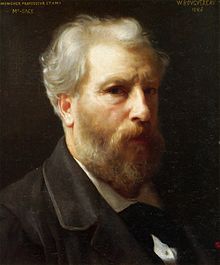William Adolphe Bouguereau
William Adolphe Bouguereau [ vijɑ̃ adɔlf buɡø'ʁo ] (also Adolphe-William Bouguereau ; born November 30, 1825 in La Rochelle ( Département Charente-Maritime ); † August 19, 1905 ibid) was a French painter of the 19th century and is considered to be Master of Academic Classicism and Classical Realism .
Life
Bouguereau was the son of the wine merchant Théodore Bouguereau (* 1800) and his wife Marie Bonnin (* 1804) and had two younger sisters. The family came from Bordeaux and had English roots.
In 1932 the family settled in Saint-Martin-de-Ré (Département Charente-Maritime). In 1837, at the age of twelve, Bouguereau came to see his uncle, a priest, in Montagne. Two years later he decided that Bouguereau should be trained as a priest at the Catholic College of Pons (Charente-Maritime) . It was at this college that Bouguereau received his first artistic instruction from Louis Sage .
His family had meanwhile settled in Bordeaux and brought him back to their home. Through the business of his family, Bouguereau soon made the acquaintance of Charles Marionneau (1823-1896), who enabled him to attend the city drawing school from the winter of 1841. Of the many drawings that were made there, only one survived to this day. In March 1846, Bouguereau went to Paris to attend the École des Beaux-Arts . At the same time, he took courses in anatomy and archeology and was interested in a. for historical costumes and uniforms.
During this time, the painter François-Édouard Picot took him on as a student in his studio and promoted Bouguereau in academic painting . In 1850 Bouguereau won the Prix de Rome and was able to stay between 1851 and 1854 in the Villa Medici of the Académie de France à Rome . He reached Rome in January 1851 and used his stay there to travel extensively to Naples, Capri, Amalfi and Pompeii. In April 1854 he returned to France and settled in Paris.
In the following year, Bouguereau was invited to take part in the annual exhibitions of the Salon de Paris and at the World Exhibition in 1855 he was able to present some of his pictures.
Honors
- 1850 Prix de Rome
plant
Bouguereau mainly painted allegories on classical and historical subjects. In the nudes, which were based on classical Greek models or their Roman copies, Bouguereau nevertheless tried to bring the "original images" to life. In his “ Birth of Venus ” (La naissance de Vénus) from 1879, for example, he intensified the movements of the body and emphasized the curves of the hips a little more than was the case with the model - Aphrodite of Cyrene (Rome, thermal bath museum). The result of these small changes, which increased the erotic charisma of “Venus”, was well received by the audience. At the same time, thanks to the ancient model, he was above any moralizing criticism.
Among his subjects, he said he would never a war paint - but probably under some circumstances the war (as an allegorical figure). As for his perfected, realistic painting technique, he once stated that the secret to being a good painter is "to see color and line as the same thing". With this statement he stood out from the academic hardliners , for whom the line always had priority over the color.
photos
Tobias says 'goodbye' to his father - Tobias disant au-revoir à son père (1860)
The Birth of Venus - La naissance de Vénus (1879)
Aurora (1881)
The Night (1883)
Hemera (1881)
The Knicks - La révérence (1898)
Student (selection)
Bouguereau taught at the Académie Julian , and one of his students was Henri Matisse , who later advocated basic artistic training at his own Académie Matisse as a teacher . Other students were:
- Georges Henri Ballot (1866–1942)
- Hans Otto Baumann (1862–1927)
- Charles Assezat de Bouteyre (1864–1942)
- Marcel Canet (1875-1958)
- Alfred Delobbe (1835-1920)
- Emilie Desjeux (1861–1957)
- Alphonse Etienne Nasreddine Dinet (1861–1929)
- Catherine Engelhart (1845-1926)
- Othon Friesz (1879-1949)
- Elizabeth Jane Gardner (1837-1922) - she married her teacher Bouguereau in 1896
- Erich Kips (1869–1945)
- Gustave Lemaître (1862-1920)
- Jean-Louis Paguenaud (1876–1952)
- Elie Anatole Pavil (1873-1948)
- Alphonse Pellet
- Auguste Privat (* 1864)
- Gaston Renault (1851-1933)
- Henri Le Riche (1868–1944)
- Jacques Simon (1875-1965)
- Lucien Simon (1861-1945)
- André Suréda (1872-1930)
- Edmund Tull (1870-1911)
- Jules-Cyrille Cavé (1859–1949)
See also
literature
- Emmanuel Bénézit : Dictionnaire critique et documentaire des peintres, sculpteurs, dessinateurs et graveurs de tous les temps et tous les pays, vol. 2 .
- Marius Vachon (1850–1928): W. Bouguereau , Paris 1899 online
- Friedrich Gross : Herald of Beauty , in: Werner Hofmann (Hrsg.): Eva and the future, the image of women since the French Revolution , exhibition catalog Eva and the future in the Hamburger Kunsthalle , July 11th - September 14th, 1986, p 97-98, Prestel, Munich 1986, ISBN 3-7913-0754-1 .
Web links
- Further information about Bouguereau (English)
- Image gallery by Bouguereau over 200 works in high resolution (English)
- Bouguereau.org about 300 paintings (English)
- William Adolphe Bouguereau in Google Arts & Culture
Individual evidence
- ^ A pupil of the painter Jean-Auguste-Dominique Ingres
| personal data | |
|---|---|
| SURNAME | Bouguereau, William Adolphe |
| ALTERNATIVE NAMES | Bouguereau, Adolphe-William (full name) |
| BRIEF DESCRIPTION | French painter |
| DATE OF BIRTH | November 30, 1825 |
| PLACE OF BIRTH | La Rochelle |
| DATE OF DEATH | August 19, 1905 |
| Place of death | La Rochelle |










